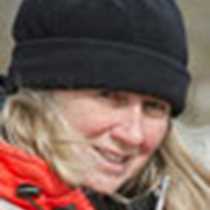<b>Streymoy, Faroe Islands</b>
<br><br>These islands rise straight from the sea. Basaltic layers pile one on top of the other rising ever higher until they seem to meet the clouds. Sea, rocks and sky are one. Where there is a slope it is by no means gentle, but it is enough for lush green vegetation to form a verdant carpet. U-shaped glacial valleys are drowned by the sea carving the land into isolated islands and islets. The surging Atlantic nibbles away at the corners cutting deep caves and towering stacks, camouflaged against the whole until one is right upon them when exploring in a tiny boat.
<bR><bR>Life seems to flourish. Fulmars throng upon the waters drawn by tasty odiferous morsels. Puffins flush from the tallest stacks swarming by the thousands like bees in the air. Shoulder to shoulder guillemots and razorbills stand on narrow ledges forming random patterns of black and white. Sheep and tiny lambs ramble contentedly on what seems to be land with impossible footing.
<br><br>And yet the climate is harsh. We visit at the summer solstice, a time of almost constant light and even though the sky is cloudy energy fills the air. But there is a nip too in the breeze and with it comes the knowledge that agriculture should not be depended on for sustenance and life. In spite of this humankind has thrived here for centuries and continues to do so by resourcefulness and ingenuity. Houses, red or black and white and occasionally blue or mustard, dot the grasslands here and there or cluster in protected harbors. In the past the food was almost solely on the cliffs or in the sea. Like spiders dangling on delicate webs they roped themselves down to collect the eggs or birds. Like goats they sprang from ship to shore scrambling upwards in pursuit of meandering sheep. More protein hides beneath the ocean waves. Fish or pilot whales, both are prey.
<br><br>The men of Vestmanna claim they are the best at foraging. Their skill at piloting their craft among the sea stacks certainly makes one believe that the sea is second nature to them. There is no fear when navigating the narrow passages. Chains or ropes dangle from on high and their memories spin tales of the year they did this or that and that no man was lost.
<bR><br>Kirkjubøur has harbored civilization since St. Brendan drifted to its shores. Rhubarb seems to be the crop of choice today mixed with grazing sheep. But within the farm house we discover evidence that once again the cliffs and sea supported life.
<br><br>Tórshavn is the town, bustling now with modern day life. Here the government meets preserving the heritage of their past and working to ensure a sustainable future.




